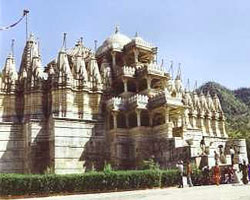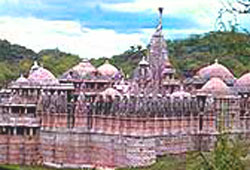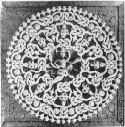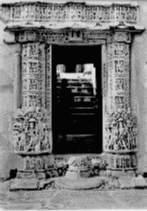| Destinations
| |||||
In the heart of the remote and enchanting valley of the Arvalli mountain range, skirting the rivulet Maghai, stands, in solemn grandeur, the Chaturmukh Jain Temple of Rishabhadev or The Ranakpur Jain Temple. This three-storeyed marble edifice, which is placed on a lofty plinth, is enveloped in the solitude of the surrounding forest. This majestic monument of devotional architecture seems bathed in celestial bliss. Rajasthan is famous for its architecural monuments. In the regular circuit map of the tourists feature the renowed Jain temples at Mount Abu and Delwara. The Ranakpur Temple is at a distance of about 96 kms from Udaipur. It is probably the most complex and extensive of Jain temples in India, covering 40,000 square feet (3600 mtrs). There are buses and private taxis connecting Ranakpur from Udaipur. The construction of the temple which had begun in 1446 Vikram Samvat, (roughly 600 years ago) took more than fifty years, to complete. It is estimated that about ninty nine lakhs of rupees were spent on the construction of the temple. |
More on Rajasthan • An Overview • Geography • People & Culture • Economy • Festivals • Wild Life • Adventure • Climate Cities • Ajmer Shareif • Bharatpur • Bikaner • Chittaurgarh • Jaipur • Jaisalmer • Jodhpur • Kota • Mount Abu • Sariska • Udaipur
Travelogues
Impressions
| ||||
The temple has four artistic entrances. In the main chamber or of the temple there are four huge white-marble images of the Jain Trithankar (Revealer of Truth) Adinath. These four images, which are about 72 inches tall, have been installed facing the four different directions. In the sanctuaries on the second and third storeys also are enshrined four identical Jain images. It is because of these four images installed together in this temple, it is popularly known as Chaturmukh (or Four faced).
The four ornate Principal Shrines are unique in their sculptural beauty.
The most outstanding feature of this temple is its infinite number of pillars. This temple can be called a treasurehouse of pillars or a city of pillars. In whichever direction one might turn one's eyes meet pillars and pillars-big, small, broad, narrow, ornate or plain. But the ingenious designer has arranged them in such a manner that none of them obstructs the view of the pilgrim wishing to have a `Darshana' (glimpse) of God. From any corner of the temple one can easily view the Lord's image. These innumerable pillars have given rise to the popular belief that there are about 1444 pillars in the temple
The domes and ceilings of this temple are replete with innumerable carvings depicting famous incidents from the past. The artists have given them life and movement with the magic touch of their chisels.
While trying to comprehend their mute language, the beholder becomes oblivious of time and space, marvelling at the workmanship. The stone-slabs depicting Sahasrafana (a cobra with thousand hoods) Parshwanath and Sahasrakuta are equally impressive.
The eroding sweep of time and nature and wanton and mindless destruction by foreign invaders did much damage to this holy shrine. For a long time it wore a deserted look as pilgrims didn't find it safe to go to this secluded place infested with wild animals and dacoits.
This renovated shrine has once again attained its unique fame in the world of art and religion. Every year thousands of art-lovers and spiritual seekers from all over the world come to this idyllic place.
Acharya Somasundarsuriji was a spiritual leader, Kumbha Rana was the King of Malghad and Dharanashah was a minister to Kumbha Rana.
A strong spiritual urge lead Dharanashah, to take an austere vow of lifelong celebacy. He soon felt the spontaneous urge to build temple of Lord Rishabhadeva, which, he resolved, should be without parallel in beauty. A legend tells us that one night, in his dream, Dharanashah had a vision of Nalinigulma Viman which is considered to be the most beautiful among the celestial planes. Dharanashah decided that the temple should resemble this heavenly Viman (plane).
He invited many reowned artists and sculptors. They submitted their plans and designs, but none could even remotely capture the Minister's dream-image. At last an easy-going sculptor named Depak from Mundara presented a plan, which simply pleased Dharanashah.
Dharanashah approached Rana Kumbha with a request to give some land for the construction of the temple. The king not only gave the land but advised Dharanashah to build a township also near the site. The site of the old village Madgi in the valley of Mount Madri was selected for the purpose. The construction of the temple and the township began simultaneously.
The town was named Ranpur after the King Kumbha Rana. Ranpur is popularly known as Ranakpur.
|
|||||
Editor: Romola Butalia (c) India Travelogue. All rights reserved. |
|||||
 The artistic sculptures, lie scattered like precious jewels. The myriad ornate `Toranas' or festoons with minute and delicate carvings are a delight to see. The innumerable elegant and lofty pillars and a large number of Shikharas, (spires) which make a unique pattern on the face of the sky.
The artistic sculptures, lie scattered like precious jewels. The myriad ornate `Toranas' or festoons with minute and delicate carvings are a delight to see. The innumerable elegant and lofty pillars and a large number of Shikharas, (spires) which make a unique pattern on the face of the sky. 
 Besides, there are also seventy six smaller domed-shrines, four Assembly halls, four Principal Shrines situated in the four directions, a number of big and small subsidiary Shrines - totalling 84 in number-stand embellishing the temple, soliciting and inspiring man to strive for emancipation from cycles of 84 lakhs of birth and death and attain eternal salvation.
Besides, there are also seventy six smaller domed-shrines, four Assembly halls, four Principal Shrines situated in the four directions, a number of big and small subsidiary Shrines - totalling 84 in number-stand embellishing the temple, soliciting and inspiring man to strive for emancipation from cycles of 84 lakhs of birth and death and attain eternal salvation. On one hand the temple has been made artistic with its two upper storeys, on the other the designer has shown foresight in constructing some nine cellars in which the sacred images could be safely preserved in the event of a crisis. It is believed that there are many Jain Images in these cellers. These cellers must be an additional strength and support to the entire structure and must have sustained it against the onslaught of time and the elements.
On one hand the temple has been made artistic with its two upper storeys, on the other the designer has shown foresight in constructing some nine cellars in which the sacred images could be safely preserved in the event of a crisis. It is believed that there are many Jain Images in these cellers. These cellers must be an additional strength and support to the entire structure and must have sustained it against the onslaught of time and the elements. Fortunately, in the Vikram Samvat, 1953 (1897 A.D); the work of administration of this shrine was handed over a local Trust, which launched an ambitious programme of renovating the temple. The renovation work continued for eleven years. The artists who set chisel to stone have lent such a delicate grace to this old structure that world-renowned architects and sculptors have lavishly praised it as one of the wonders of the world.
Fortunately, in the Vikram Samvat, 1953 (1897 A.D); the work of administration of this shrine was handed over a local Trust, which launched an ambitious programme of renovating the temple. The renovation work continued for eleven years. The artists who set chisel to stone have lent such a delicate grace to this old structure that world-renowned architects and sculptors have lavishly praised it as one of the wonders of the world.  This temple is the realization of the vision and endeavours of four great and devout seekers. They were: Acharya Somasundarsuriji, Dharanashah, Kumbha Rana or Rana Kumbha, Depa or Depaka.
This temple is the realization of the vision and endeavours of four great and devout seekers. They were: Acharya Somasundarsuriji, Dharanashah, Kumbha Rana or Rana Kumbha, Depa or Depaka.